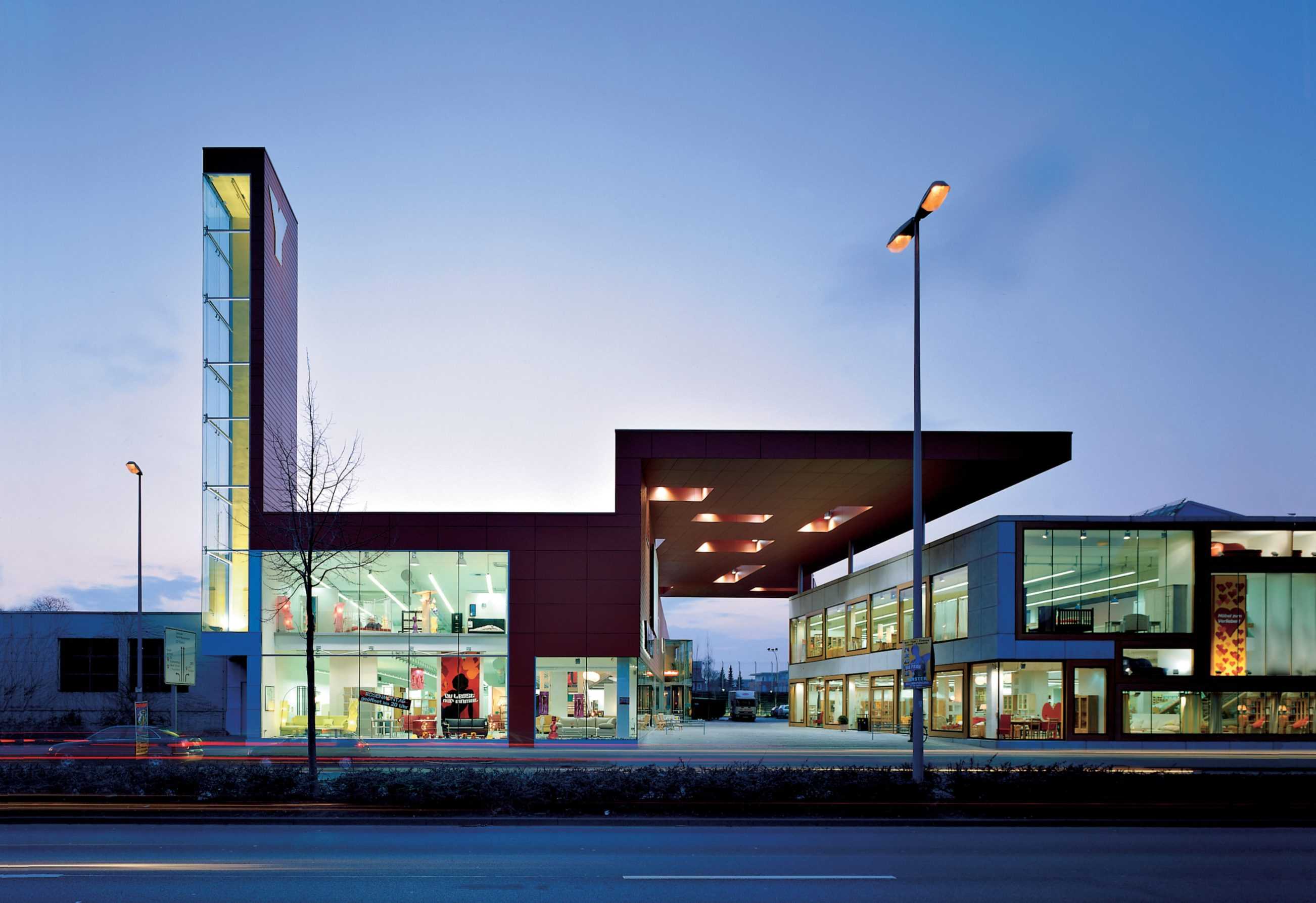
Falkenried
TYPOLOGY: Masterplan, Residential, Office
COUNTRY: Germany
CITY: Hamburg-Eppendorf
YEAR: 2004
COMPETITION: Masterplan Competition 1999, First Prize
GFA: 34.500 sqm
CLIENT: Bayerische Hausbau GmbH, Munich
AWARDS: German Urban Planning Award 2004
PHOTOS: © Christian Richters
The anatomy of redundant bus and tram workshop/sheds was co-opted as the organising template for this 1999 premiated Quartier Masterplan. An east west piazza focusses the networked block interior.
The principles of the Masterplan were: The ‘loftising’ of one workshop shed, a brick administration building which grows into penthouses and bus garage doors which envelope row-houses.
Southward from the piazza a spatial choreography of Office Slab and Housing Tower leads over a raised terrace with a second (zigzag) office facade, past a café/bar, down an Eisenstein stair to street and canal. This perspectival sequence – an opening and closing of large scale urban rooms – is homogenised by its rich and tactile material, a ‘Hamburg-solid turf-fired brick’.

















Wohn und Stadtbau Housing Association Headquarters
TYPOLOGY: Office
COUNTRY: Germany
CITY: Munster
YEAR: 2004
COMPETITION: 2001, First prize
CLIENT: Wohn und Stadtbau GmbH
PHOTOS: © Christian Richters
Entering the city from the north, a straight road, at the apex of its perspectival triangle a silhouette of cathedral and other church towers. Progressing into this picture, slightly downhill the view is gradually obscured, the outer traffic ring crossed.
The next 500 m rise, not a dramatic topography but enough to awaken expectation – ‘up there I will be in the city’. Buildings on the right enclose and to some extent counteract the latent drama of this ascent, this arrival. The left is undergoing a transformation, a re-configuring, a chance for a modulated roofline to enhance topographic character.
This is the intention of the sculpted silhouette of the new offices of the ‘Wohn+Stadtbau’ Housing Association. Its crest location is critical. The structured plaster façades of both volumes do not just echo but enhance site topography and the drama of entrance.
Entering the building involves a counter and smaller scale spatial sequence. The building front steps back from the heavily trafficked street to a transparent foyer. The ground floor facilitates intensive visitor traffic, waiting spaces extend into the internal court and playground.







RS+Yellow Furniture
TYPOLOGY: Retail
COUNTRY: Germany
CITY: Münster
YEAR: 2003
GFA: 7.700 sqm
CLIENT: Rainer Scholze
AWARDS: Award for Exemplary Corporate Architecture in NRW 2004
PHOTOS: © Christian richters
‘A staging of shopping’. The widespan shop outlet typology usually situated on the periphery is here reconstituted as an urban facade, city near and addressing the city bound / city exiting traffic. Three stores (RS, Yellow, Brands) with an overall shop area of 5.000 m2 cluster with warehouse and delivery bays, around an internal parking piazza. An advertising tower erupts on one corner, a supersign, a new actor in the quartier’s tower landscape (Trinity Church and Fire Station Tower).
A theatrically proportioned roof frames the pedestrian/car entrance. This transition space is a constructed perspective (rejecting any ideal viewing point), a reciprocal scenographic framing of inner and outer world. The hovering roof grows out of and connects the two larger shops. Logistics are critical – 18 m long lorries cross the piazza and disappear into the building.
The exaggerated scale of the wooden window frames in RS (which sells wooden furniture) are stacked like boxes (These 35 cm wide frames sidestep a local building regulation that prohibits wooden facades on retail structures). A dialogue between contained and container that continues in the interior detailing. Both structure (prefabricated concrete) and the materiality (fibre-cement panels) of the facades respond with an economic and systemized appropriateness to the ‘outlet’ building type.
















vZvdG House
TYPOLOGY: Residential
COUNTRY: Netherlands
CITY: Enschede
YEAR: 2005
PHOTOS: ©BOLLES+WILSON
Following the disastrous explosion of a fireworks factory in Enschede NL the new district masterplan by Pi de Bruijn, required a row of modernist villas along the new Museumlaan.
The somewhat draconian masterplan also specified that only architects of international repute could build here (BOLLES+WILSON was pleased to find their Italian chum Cino Zucchi as neighbour).
The masterplan required modernist villas, flat roofs – a geometric play of volumes. The Villa vZvdG almost fell of the list by being too small – But the east facing sun shaded terrace pumped it up to an acceptable volume. The owners, a couple with a teenaged son, needed a separately accessed office and an interior that allowed for constant rehanging of their painting collection – Petersburg hanging system. The façade of fibre cement panels is green + white striped (the traditional colours of barn doors in the east of the Netherlands). Because white stripes could not run around the corner (vertical green profile) the stripes were slipped up or down at the corner – the working title of the house was “Vertical Glitch House”.





















Himmelsscheibe Exhibition Centre
TYPOLOGY: Cultural
COUNTRY: Germany
CITY: Nebra
YEAR: 2004
COMPETITION: Invited competition
AWARDS: Special price
An observation Tower connects an archaeological dig to its wider landscape. Nearby the Corten clad visitors centre with its cargo of sky disk (4,000 years old sky map) paraphernalia wriggles a few metres above rolling fields casting at its extremity a laconic glance skywards.














